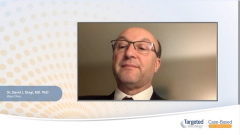
Impact of Teclistamab on the Management of Relapsed/Refractory Multiple Myeloma
Expert perspective on teclistamab, a bispecific antibody, in the context of multiple myeloma treatment, discussing its potential benefits and associated considerations.
Episodes in this series

Transcript:
David M. Dingli, MD, PhD: So teclistamab was the first bispecific antibody that has been approved for the therapy of relapsed/refractory multiple myeloma after 4 prior lines of therapy. So the bispecific antibodies, one can think of [them] as almost being a CAR [chimeric antigen receptor] T [cell] in a bottle. In CAR T, the autologous T cells are engineered to express a chimeric receptor that can target BCMA [B-cell maturation antigen]. And therefore, these T cells can engage with the myeloma cells that get activated, proliferate, and form memory cells and also kill the tumor cells.
In the case of [a] bispecific antibody, the antibody serves as a bridge between the BCMA-expressing myeloma cell and the CD3-expressing T cells. All our T cells in the body express CD3, so the drug serves to bring T cells close to the multiple myeloma cells, and the interaction results in T-cell activation and killing of the multiple myeloma cells. Indeed, if one looks at the potential toxicity related to bispecifics, they are similar to what one expects with [CAR] T therapy, except the incidence and severity of the [adverse] effects tend to be significantly lower.
To address the question of the MajesTEC-1 trial [NCT04557098], in this trial, patients with relapsed/refractory disease were enrolled in phase 1 and then a phase 2 trial with single-agent teclistamab. In the end, the approval required a step-up dosing of the teclistamab, as I’m sure we’ll talk about later. But these patients were relapsed/refractory, they received the drug subcutaneously or intravenously, [and] ultimately it was decided that the drug should be given subcutaneously. Of course, the recommended phase 2 dose was determined based on the phase 1 portion of the study, and the patients were enrolled, and they’ve been followed up for considerable time, with the data being very mature.
The main outcomes from the study were, of course, overall response rate, the depth of response, progression-free survival, as well as overall survival together with potential toxicity and tolerability of the agent. The drug is actually very well tolerated, and the response rates are quite high, with an overall response rate of around 63%. Now, the patients who were enrolled in the study initially had no prior BCMA exposure, so they were BCMA naive. The overall response rate was around 63%. The median duration of response is approximately 30 months, but the overall duration of response is approaching almost 2 years. With step-up dosing, the incidence of toxicities is actually quite mild.
The cytokine release syndrome occurs typically in [or after] the first few injections, and we give the lowest dose on day 1, subsequently another dose on day 3, and by day 5 or day 7, we will give the 1.5-mg/kg dose. And patients then go on to weekly therapy, as per the label. As I mentioned, the patients tolerate the drug quite well. When I practice, I typically treat patients in the outpatient setting. If the patient develops fever and…cytokine release syndrome, they can be treated, and we’ll address that in a bit. Apart from the risk of cytokine release syndrome, the risk of neurotoxicity appears to be quite low and generally short-lived, typically grade 1 or grade 2 at most.
There are some other toxicities as reported in the study, and most of these are hematologic, typically cytopenias, whether [they’re] anemia or neutropenia or thrombocytopenia. The [adverse] effects are reversible, either by holding therapy for some time, and of course, it’s important to always look for other potential causes of cytopenias, in particular, CMV [cytomegalovirus] reactivation. The neutropenia also responds very nicely to the use of G-CSF [granulocyte colony-stimulating factor].
So compared with what else would have been available for patients before teclistamab was available, these responses are spectacular. As I mentioned already, prior to the availability of these agents, median survival for a patient with relapsed/refractory, pentarefractory disease would be several months. So now we’re seeing responses that last more than [1] year and overall survival is certainly greater than 2 years for many patients. So the responses and the efficacy of these agents are really a revolution for these patients, and they provide a very important need for patients with relapsed/refractory disease.
Transcript is AI-generated and edited for readability.









































